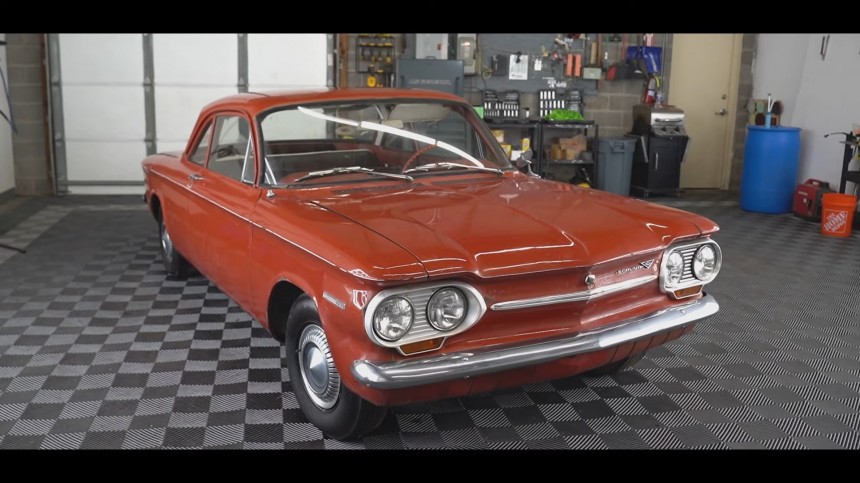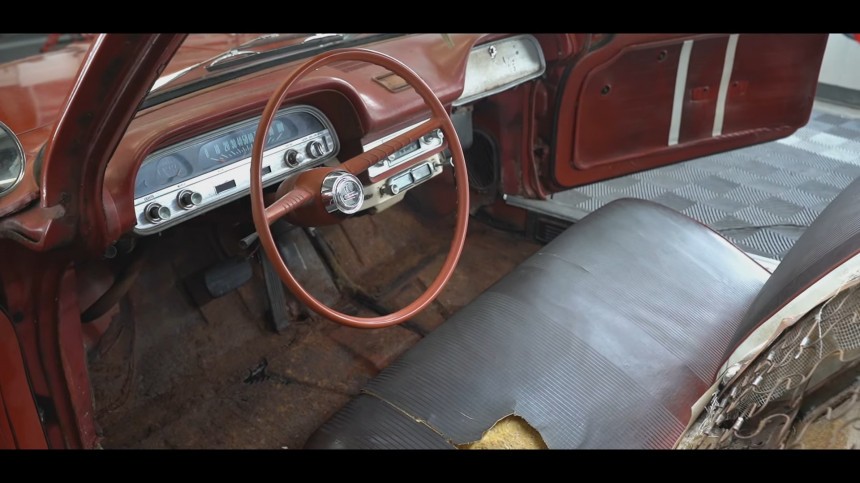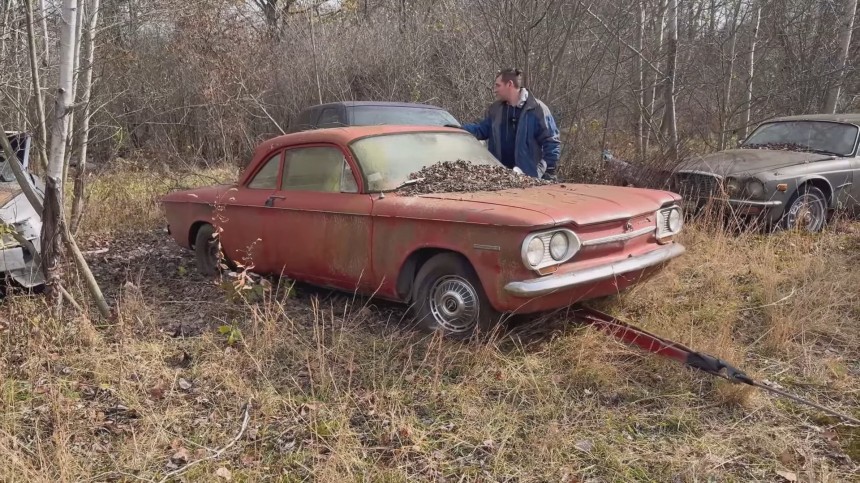Between 1960 and 1969, Chevrolet built one of the most interesting, intriguing, controversial, deviant, defiant, non-conformist, and unrightfully bashed automobiles ever to come out of Detroit. The Corvair was a compact that proposed a new paradigm for domestic motoring, one so radical that it was almost considered a mutiny. Undeservingly criticized back in its heyday, the nameplate is now long gone, but when one pops up, it’s nearly certain to stir interest.
When the Toronado debuted the front-wheel-drive platform in 1966, the perfectly flat floor was one of the key features underscored by sales literature. The lack of a transmission tunnel left more room for the occupants. But that wasn’t exactly breaking news for Chevy loyalists, as six years before the personal luxury Oldsmobile, the humble compact Corvair advocated a similar space-saving design.
But the key difference between the two General Motors products, placed at opposite ends of the price, size, plushness, and target market spectrum, was that the Corvair didn’t use the front wheels to work double shifts in doing both the turning and the traction.
The compact Chevy instead replicated a European design and placed the engine behind the rear axle, in the trunk. Chevrolet went all in, put the gearbox in front of the engine, crammed the differential between them, and called it a day.
The transmission and final drive gears were combined in a compact unit. At the same time, the diff was a very awkward design, to allow the power to be sent from the six-cylinder powerplant to the gearbox. An input shaft ran straight through the hollow differential hypoid pinion and transmission output shaft. As if that wasn’t unorthodox enough, the Corvair also had a V6 all-aluminum engine.
Put the keyboards down for one more second: yes, the cylinders were horizontally opposed, placed in the same plane as the crankshaft, virtually making the architecture a 180-degree Vee type. The solution wasn’t a novelty in the industry – Porsche and Volkswagen were fanatic supporters – but an American-made flat-six was quite the talk of the town.
Unfortunately, the Corvair was cursed with a spell that made waves in the mid-sixties, when Ralph Nader’s book, ‘Unsafe at Any Speed,’ absolutely mopped the floors with the poor Chevy right in the first chapter. It also bashed other makes and models in the following chapters, but the Corvair had it worst. Many now believe the book was the rider of the apocalypse for the nameplate, but that’s not accurate – not in a million years.
The book appeared in 1965, while the car was retracted in 1969. Also, Nader based his accusations on a 1960 model and made it sound as if subsequent model years all had the same design flaw. In truth, Chevrolet righted the wrong about their car by updating the rear axle.
For example, the 1964 Corvairs still used the swing axles but also included a transverse leaf spring which eliminated the possibility of rear wheel tuck under.. That’s what the book claimed to be the fatal flaw in the Corvair: at certain speeds and under specific driving conditions, the car could flip due to its axles jacking up the car.
The Corvair took nine years from idea to mass production – Chevrolet took its time with the development, a stark contrast to what the division did with the Camaro, for example. It shows that sometimes a carefully planned product can be knocked out by another one that took four times less to put together. That’s one of the reasons the Corvair was canceled – the Bowtie pony car’s explosive popularity almost immediately outshone the rear-engined compact.
Nonetheless, the Corvair was deemed good enough to serve as a platform for performance for one of the greatest names in the history of Chevrolet racing. Don Yenko – the father of the COPO system – built his Stingers out of Corvairs.
A fatally bad car couldn’t have made it that far up the ladder, particularly since the first Yenko Stingers broke ground in 1966 when Nader’s book was fresh out of the oven and stirred a commotion in the United States of Automobile.
Why the long introduction? Because I very much like the Corvair, for all its quirkiness and originality, independent tests from 1974 proved that Nader was dead wrong. The Corvair wasn’t any more dangerous than other contemporary compacts. And when I see one getting a well-deserved rescue and detailing after sitting in a field for the last 46 years, I need no extra reasons to share it with you.
All courtesy of the merry lads from the Wagner DiCesare Detailing enterprise, better known on social media as WD Detailing. They found a 1963 Corvair 500 Club Coupe – a spitting image of the car pictured in the official brochures from that year – stuck between trees that grew around it. In a most non-typical manner, the detailers don’t say where the Chevy was found, how it got there, how many miles it was on, or any other details about its past.
So, we’re left with what we see – which is quite a gem, to be honest, since it sports air conditioning. 1963 was Corvair's third-best year, with almost 290,000 units assembled in the USA and Canada. Roughly two-and-a-half percent of them had the cool optional extra - or about 7,250 examples. This red survivor is one of those. What’s more interesting is the fact that the add-on was ordered on the base Corvair 500, the cheapest model offered.
With a base price of $1,992, the rear-wheel-driven Chevy didn’t offer much as standard, so the 350 bucks spent on air conditioning was quite the investment. It also mandated a radio – due to the unique configuration of the dashboard installed on A/C cars. But that’s all there is to the weather-related particularities of this fascinating automobile.
Two vents under the rear seats blew hot air from the engine (and reportedly a considerable quantity of exhaust fumes). Because it sat for 46 years in a field guarded by living wood, this example sports the Flintstone floor pan. The entire left rear foot well is gone, the assiduous work of humidity creeping from the underside.
Surprisingly, the rest of the car is in pretty good shape, all things considered, and the detailing job actually worked wonders on the body. We don’t know the state of the engine (if it's seized or not), but I, for one, would love to see this car back on the road one day (preferably sooner rather than later). In 1963, the powerplant was an air-cooled 145-cubic-inch flat-six (2.4-liter), tuned at 80 or 102 hp in the 500 series.
The two-speed Powerglide automatic gearbox was also an option ($157), and its notorious lack of a ‘Park’ transmission lock made towing a Corvair an adventure. Due to its innate ability to kick-start when pushed and shifted Into the ‘Low’ range, the Corvair was prone to accidental start-ups if the gearbox slipped from Neutral into a driving range while gently rolling behind a tow truck, front-end hooked up in the air.
But the key difference between the two General Motors products, placed at opposite ends of the price, size, plushness, and target market spectrum, was that the Corvair didn’t use the front wheels to work double shifts in doing both the turning and the traction.
The compact Chevy instead replicated a European design and placed the engine behind the rear axle, in the trunk. Chevrolet went all in, put the gearbox in front of the engine, crammed the differential between them, and called it a day.
The transmission and final drive gears were combined in a compact unit. At the same time, the diff was a very awkward design, to allow the power to be sent from the six-cylinder powerplant to the gearbox. An input shaft ran straight through the hollow differential hypoid pinion and transmission output shaft. As if that wasn’t unorthodox enough, the Corvair also had a V6 all-aluminum engine.
Unfortunately, the Corvair was cursed with a spell that made waves in the mid-sixties, when Ralph Nader’s book, ‘Unsafe at Any Speed,’ absolutely mopped the floors with the poor Chevy right in the first chapter. It also bashed other makes and models in the following chapters, but the Corvair had it worst. Many now believe the book was the rider of the apocalypse for the nameplate, but that’s not accurate – not in a million years.
The book appeared in 1965, while the car was retracted in 1969. Also, Nader based his accusations on a 1960 model and made it sound as if subsequent model years all had the same design flaw. In truth, Chevrolet righted the wrong about their car by updating the rear axle.
For example, the 1964 Corvairs still used the swing axles but also included a transverse leaf spring which eliminated the possibility of rear wheel tuck under.. That’s what the book claimed to be the fatal flaw in the Corvair: at certain speeds and under specific driving conditions, the car could flip due to its axles jacking up the car.
Nonetheless, the Corvair was deemed good enough to serve as a platform for performance for one of the greatest names in the history of Chevrolet racing. Don Yenko – the father of the COPO system – built his Stingers out of Corvairs.
A fatally bad car couldn’t have made it that far up the ladder, particularly since the first Yenko Stingers broke ground in 1966 when Nader’s book was fresh out of the oven and stirred a commotion in the United States of Automobile.
Why the long introduction? Because I very much like the Corvair, for all its quirkiness and originality, independent tests from 1974 proved that Nader was dead wrong. The Corvair wasn’t any more dangerous than other contemporary compacts. And when I see one getting a well-deserved rescue and detailing after sitting in a field for the last 46 years, I need no extra reasons to share it with you.
So, we’re left with what we see – which is quite a gem, to be honest, since it sports air conditioning. 1963 was Corvair's third-best year, with almost 290,000 units assembled in the USA and Canada. Roughly two-and-a-half percent of them had the cool optional extra - or about 7,250 examples. This red survivor is one of those. What’s more interesting is the fact that the add-on was ordered on the base Corvair 500, the cheapest model offered.
With a base price of $1,992, the rear-wheel-driven Chevy didn’t offer much as standard, so the 350 bucks spent on air conditioning was quite the investment. It also mandated a radio – due to the unique configuration of the dashboard installed on A/C cars. But that’s all there is to the weather-related particularities of this fascinating automobile.
Surprisingly, the rest of the car is in pretty good shape, all things considered, and the detailing job actually worked wonders on the body. We don’t know the state of the engine (if it's seized or not), but I, for one, would love to see this car back on the road one day (preferably sooner rather than later). In 1963, the powerplant was an air-cooled 145-cubic-inch flat-six (2.4-liter), tuned at 80 or 102 hp in the 500 series.
The two-speed Powerglide automatic gearbox was also an option ($157), and its notorious lack of a ‘Park’ transmission lock made towing a Corvair an adventure. Due to its innate ability to kick-start when pushed and shifted Into the ‘Low’ range, the Corvair was prone to accidental start-ups if the gearbox slipped from Neutral into a driving range while gently rolling behind a tow truck, front-end hooked up in the air.



































